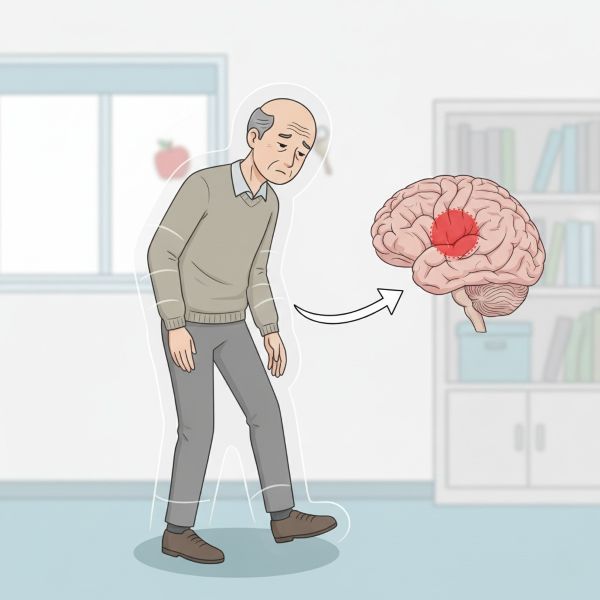Akinesia
Definition and Clinical Spectrum
Akinesia is an inability to initiate voluntary movements. More commonly in clinical practice, there is a difficulty—a reduction or delay—in initiating movement, a state perhaps better termed bradykinesia (slowness of movement) or hypokinesia (reduced amplitude of movement). These difficulties cannot be attributed to weakness from pyramidal system dysfunction. Interestingly, reflexive motor activity may be preserved (kinesis paradoxica).
Pure akinesia, without rigidity or tremor, can occur. If it is responsive to levodopa, it is usually due to Parkinson’s disease; if it is unresponsive, it may be a forerunner of progressive supranuclear palsy. A unilateral form, hemiakinesia, may be a feature of motor neglect.

Akinesia, a 'poverty of movement,' is a core feature of parkinsonism, leading to difficulty with initiating actions like walking.
Pathophysiology and Anatomical Correlates
Neurophysiologically, akinesia is critically associated with the loss of dopamine projections from the substantia nigra to the putamen. Neuroanatomically, it is a feature of disorders affecting a network of structures including:
- Frontal-subcortical circuits (e.g., the medial convexity subtype of frontal lobe syndrome)
- Basal ganglia
- Ventral thalamus
- Limbic system (particularly the anterior cingulate gyrus)
Bilateral pathology affecting these circuits can lead to a severe state of bilateral akinesia with mutism, known as akinetic mutism.
Causes and Associated Conditions
The pathological processes that can cause akinesia are diverse:
- Neurodegeneration: This is the most common cause, including Parkinson’s disease, progressive supranuclear palsy (PSP), multiple system atrophy (MSA), and late-stage Pick’s or Alzheimer’s disease.
- Hydrocephalus
- Neoplasia: For example, a "butterfly glioma" affecting both frontal lobes.
- Cerebrovascular disease
Clinical Significance and Treatment
The presence of akinesia (or bradykinesia) is considered an absolute requirement for the clinical diagnosis of parkinsonism. Akinesia resulting from nigrostriatal dopamine depletion, as in idiopathic Parkinson’s disease, often responds well to treatment with levodopa or dopamine agonists. However, many other parkinsonian and akinetic-rigid syndromes show no, or only a partial, response to these agents.
References
Imai H. Clinicophysiological features of akinesia. European Neurology 1996; 36(suppl 1): 9-12
Cross References
Akinetic mutism; Bradykinesia; Extinction; Frontal lobe syndromes; Hemiakinesia; Hypokinesia; Hypometria; Kinesis paradoxica; Neglect; Parkinsonism

